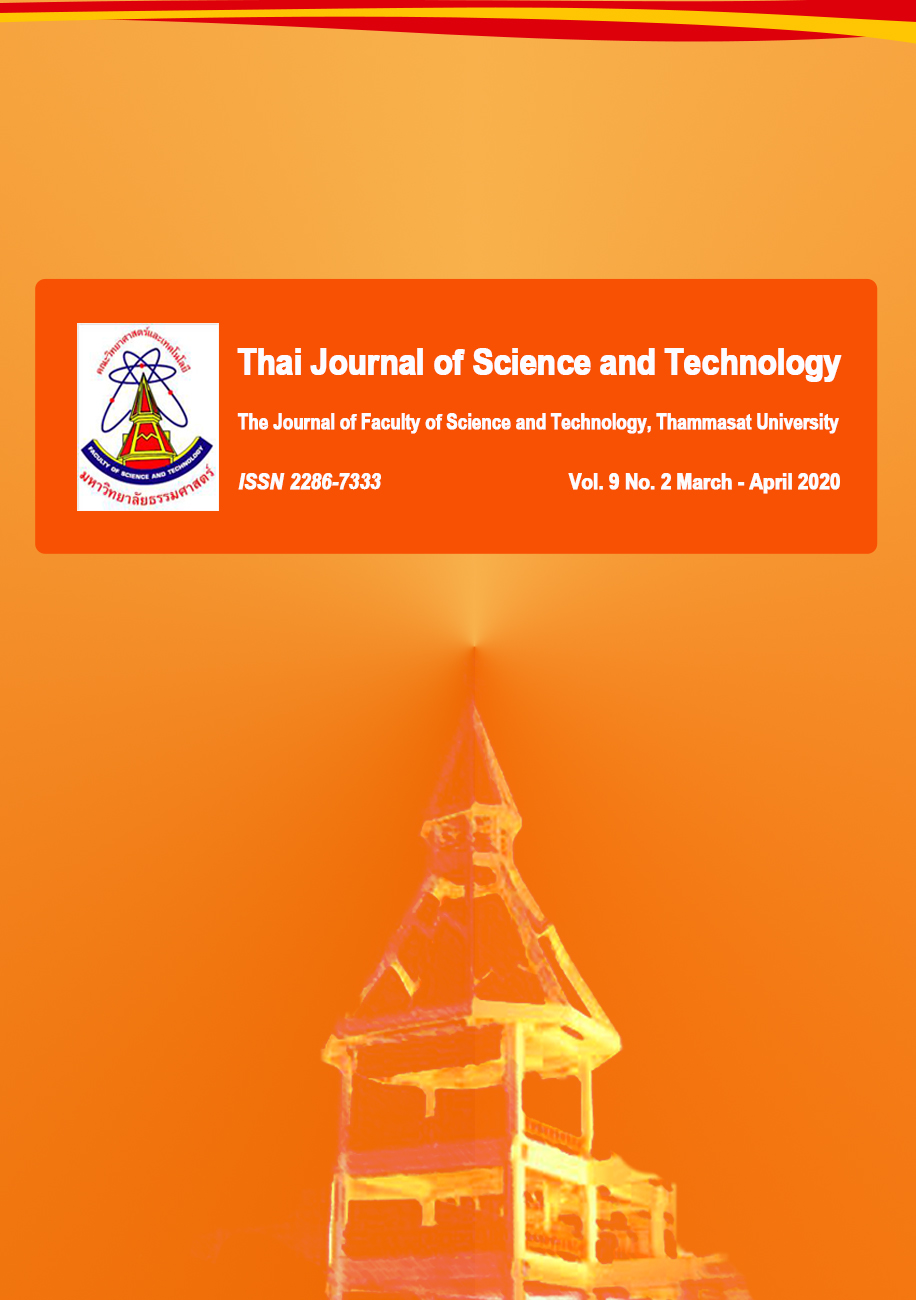การพัฒนาผลิตภัณฑ์กัมมี่เยลลี่มะม่วงหาวมะนาวโห่
Main Article Content
Abstract
The aims of this research were to develop gummy jelly with the fruit juice of Karanda (Carissa carandas L.) at fully-ripened stage, and to measure the effect of Karanda juice in quantities of 150, 250 and 350 g on the quality of gummy jelly. The effect of using maltitol to replace sucrose on the quality of Karanda gummy jelly was also studied. For chemical properties, the water activity (aw) was in a range of 0.87-0.90 and the pH was in a range of 2.84-3.34. Increasing the levels of Karanda juice showed a tendency to increase the lightness (L*), redness (a*) and yellowness (b*) values and the pH value (p ≤ 0.05). The Karanda juice caused changes in the texture properties of gummy jelly indicated by a decrease in hardness, chewiness, and springiness of the products (p ≤ 0.05). Hedonic scores showed that the overall liking of the Karanda gummy jelly product by using 250 g Karanda juice was moderate to high (p ≤ 0.05). Moreover, the sucrose was replaced by maltitol at percentages of 0, 50 and 100 (w/w). The results showed that the addition of maltitol tended to increase the lightness (L*), redness (a*) and yellowness (b*) values, the pH value and water activity (aw) of the product (p ≤ 0.05), while the hardness and chewiness were decreased (p ≤ 0.05). However, in gummy jelly produced from 100 % maltitol, it was not significantly different in overall liking over the replacement of 50 % maltitol. The replacement of sucrose by maltitol up to 100 % would be recommendable to develop healthy Karanda gummy jelly.
Article Details
บทความที่ได้รับการตีพิมพ์เป็นลิขสิทธิ์ของคณะวิทยาศาสตร์และเทคโนโลยี มหาวิทยาลัยธรรมศาสตร์ ข้อความที่ปรากฏในแต่ละเรื่องของวารสารเล่มนี้เป็นเพียงความเห็นส่วนตัวของผู้เขียน ไม่มีความเกี่ยวข้องกับคณะวิทยาศาสตร์และเทคโนโลยี หรือคณาจารย์ท่านอื่นในมหาวิทยาลัยธรรมศาสตร์ ผู้เขียนต้องยืนยันว่าความรับผิดชอบต่อทุกข้อความที่นำเสนอไว้ในบทความของตน หากมีข้อผิดพลาดหรือความไม่ถูกต้องใด ๆ
References
เฉลิมพล ถนอมวงศ์, 2552, ผลของเจลาตินและกรดซิตริกต่อคุณภาพทางประสาทสัมผัสของกัมมี่เยลลี่รสตะไคร้, ว.วิทยาศาสตร์ มข. 37(3): 325-332.
ณัชชากร วรสาร, นภภัค ใจภัคดี และเอกพล ลิ้มพงษา, 2560, การเตรียมและประเมินผลิตภัณฑ์กัมมี่เยลลี่ที่มีส่วนผสมของกลูโคแมนแนน, น. 932-939, ใน การประชุมวิชาการเสนอผลงานวิจัยระดับบัณฑิตศึกษาระดับชาติและนานาชาติ, มหาวิทยาลัยขอนแก่น, ขอนแก่น.
นราธิป ปุณเกษม, 2556, การพัฒนาผลิตภัณฑ์กัมมี่สมุนไพรไทยแคลอรี่ต่ำ : ขิง, มหาวิทยาลัยราชภัฏสวนดุสิต, กรุงเทพฯ.
นิธิยา รัตนาปนนท์, 2554, หลักการวิเคราะห์อาหาร, โอเดียนสโตร์, กรุงเทพฯ.
ปิยนุสร์ น้อยด้วง และนคร บรรดิจ, 2558, การใช้มอลทิทอลและซูคราโลสในการผลิตคุกกี้เนยแคลลอรี่ต่ำ, สมาคมสถาบันอุดมศึกษาเอกชนแห่งประเทศไทย ในพระบรมราชูปถัมภ์สมเด็จพระเทพรัตนราชสุดาฯ สยามบรมราชกุมารี 4(2): 42-51.
พิชญานิน เพชรล้อมทอง และปุณฑริกา รัตนตรัยวงศ์, 2557, น้ำตาลและสารให้ความหวานกับแนวทางการบริโภคในยุคปัจจุบัน, ว.เกษตรพระจอมเกล้า 32(1): 77-86.
ภาสุรี ฤทธิเลิศ. 2560. คู่มือการแปรรูปผลไม้แช่อิ่มอบแห้ง: มะม่วงหาวมะนาวโห่, คณะเทคโนโลยีการเกษตร มหาวิทยาลัยราชภัฏวไลยอลงกรณ์ ในพระบรมราชูปถัมภ์, ปทุมธานี.
วชิราภรณ์ ผิวล่อง, สุรศักดิ์ สัจจบุตร, ศิริลักษณ์ สิงห์เพชร, และจารุรัตน์ เอี่ยมศิริ, 2556, อิทธิพลของระยะเวลาสุกต่อสารออกฤทธิ์ทางชีวภาพของมะม่วงหาวมะนาวโห่, ว. วิทย์. กษ. 44(2)(พิเศษ): 337-340.
ศิมาภรณ์ มีแสง, ไพศาล วุฒิจานงค์, รุ่งนภา พงศ์สวัสดิ์มานิต, และสุมนรัตน์ ชื่นพุฒิ, 2546, ผลของเจลาติน อัตราส่วนของซูโครส/กลูโคสไซรัป และกรดซิตริกต่อสมบัติทางกายภาพและคุณภาพทางประสาทสัมผัสของผลิตภัณฑ์กัมมี่เยลลี่, น. 20-27, ใน การประชุมทางวิชาการของมหาวิทยาลัยเกษตรศาสตร์ ครั้งที่ 41, มหาวิทยาลัยเกษตรศาสตร์ กรุงเทพฯ.
สุขใจ ชูจันทร์, 2555, สารให้ความหวานพลังงานต่ำ, สำนักพิมพ์แห่งจุฬาลงกรณ์มหาวิทยาลัย, กรุงเทพฯ.
สุภาพร ฟักเงิน และศิรประภา มีรอด, 2560, การสกัดแยกหาปริมาณแอนโทไซยานินจากลูกมะม่วงหาวมะนาวโห่, น. 1002-1011, ใน การประชุมวิชาการระดับชาติ ครั้งที่ 4, สถาบัน วิจัย มหาวิทยาลัยราชภัฏกำแพงเพชร, กำแพงเพชร.
สุภาพร อภิรัตนานุสรณ์, 2554, การพัฒนาแยมมังคุดแคลลอรี่ต่ำผสมเปลือกมังคุด, KKU Res. J. 16(7): 825-834.
สุวรรณา สุภิมารถ, 2543, เทคโนโลยีการผลิตลูกกวาดและช็อกโกแลต, สำนักพิมพ์แห่งจุฬาลงกรณ์มหาวิทยาลัย, กรุงเทพฯ.
สำนักงานมาตรฐานผลิตภัณฑ์อุตสาหกรรม, 2547, มาตรฐานผลิตภัณฑ์ชุมชนเยลลี่แห้ง, มผช. 520-2547, กรุงเทพฯ.
AOAC, 2000, Official Methods of Analysis. 17th Ed., Association of Official Analytical Chemists, Gaithersburg, MD.
BAM, 2001, Bacteriological Analytical Manual Online, Food and Drug Administration, Silver Spring, MD.
Ervin, G. and Ervin, E., 2011, Health Charac teristic Chewy or Gummy Candy Confection, Available Source: https://patentimages.storage.googleapis.com/fa/e2/c8/dde19d51789f2d/US20110313055A1.pdf, October 1, 2019.
Evageliou, V., Mazioti, M. Mandala, I. and Komaitis, M., 2010, Compression of gellan gels, Part II: Effect of sugars, Food Hydrocoll. 24: 392-397.
Jiamjariyatam, R., 2018, Influence of gelatin and isomaltulose on gummy jelly properties, Int. Food Res. J. 25: 776-783.
Kearsley, M.W. and Deis, R.C., 2006, Maltitol and Maltitol Syrups, In Mitchell, H.L. (Ed.), Sweeteners and Sugar Alternative in Food Technology, Blackwell publishing, Ltd., Oxford.
Lindley, M.G., 2002, Developments in high potency sweeteners, Int. Sugar J. 104: 346-351.
Maheshwari, R., Sharma, A. and Verma, D., 2012, Phyto-therapeutic Significance of Karaunda, Bull. Environ. Pharm. Life Sci. 1(12): 34-36.
Marfil, P., Anhe, A. and Telis, V., 2012, Texture and microstructure of gelatin/corn starch based gummy confections, Food Biophys. 7: 236-243.
Nabor, B.O.L., 2001, Alternative Sweeteners, 3rd Ed., Revised and Expanded, Marcel Dekker, Inc., New York.
Periche, A., Heredia, A., Escriche, I., Andres A. and Castello, M.L. 2014, Optical, mechanical and sensory properties of based-isomaltulose gummy confections, Food Biosci. 7: 37-44.
Poppe, J., 1997, Gelatin, pp. 144-159, In Imeson, A. (Ed.), Thickening and Gelling Agents for Food, 2nd Ed., An Imprint of Chapman & Hall, London.
Rozzi, N.L., 2007, Sweet Facts about Maltitol, Available Source: http://nfscfaculty.tamu.edu/talcott/courses/FSTC605/Food%20Product%20Design/Maltitol.pdf, October 4, 2019.
Tau, T. and Gunasekaran, S., 2016, Thermorheological evaluation of gelatin of gelatin with sugar substitutes, LWT Food Sci. Technol. 69: 570-578.


